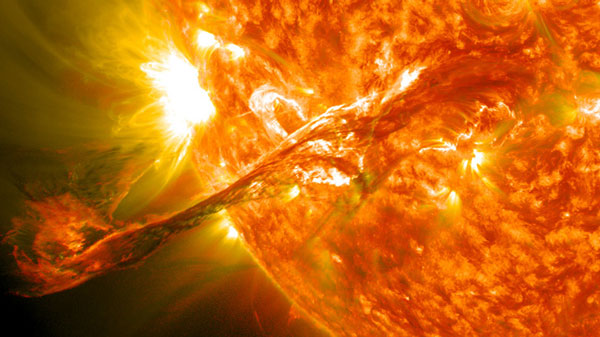
Meteorites Tighten Timeline for Giant Planets’ Movement through the Solar System
By linking a family of meteorites on Earth to their relatives in the asteroid belt, scientists have arrived at a new understanding of the giant planets' movement early in the solar system's history.

Giant Ancient Volcano Discovered on Mars
Scientists have identified a colossal volcano on Mars using satellite imagery. It was undetected for decades due to extensive erosion.

Icy Impactor Might Explain the Formation of Mars’s Moons
In a new study, scientists suggest an impact with a giant icy object could explain the formation of Mars's moons, Phobos and Deimos.

Methane Icebergs Could Float in Titan’s Seas
The “magic islands” that appear and disappear in Titan’s methane-ethane seas could be hydrocarbon icebergs, a new study finds.

“Rogue Black Hole” Could Be Something Much Simpler
An unusual streak of stars thought to have formed in the wake of a wandering supermassive black hole might just be a spiral galaxy seen edge-on.

The Sun's Ramping Up Activity — But Still Weaker Than in the Past
The Sun has recently experienced an uptick in activity, with lots of sunspots accompanied by flares, coronal mass ejections, and visible auroras — but experts still expect a mild solar cycle.

85,000 Volcanoes Mapped on Venus
A new catalog pinpoints volcanic cones in the best available surface images of Venus – those gathered 30 years ago by NASA’s Magellan spacecraft.

Native American Full Moon Names for 2023
Native American tribes each had their own full Moon names — we introduce the most commonly used ones and the traditions behind them.

Meteorite Evidence Suggests Earth’s Water Was Here Before Earth Was
Where did Earth’s water come from? One of the oldest meteorites on Earth is adding new pieces to an old puzzle.

Mars Hosted Supervolcanoes in the Ancient Past
Scientists have found massive ash deposits that formed over millions of years of volcanic super-eruptions, the first evidence for such explosive activity on Mars.

NASA’s Curiosity Takes Step Toward Solving Mars Methane Mystery
New measurements from NASA’s Curiosity rover show that methane concentrations near the Martian surface vary on a daily cycle. The finding could help reconcile conflicting data.

Radioactive Aluminum Sheds Light on Solar System History
Astronomers thought giant stars were reponsible for flooding the early system with a radioative isotope — but the Sun itself might have made it.

Long-lived Lunar Magma Ocean Points to a Younger Moon
Most lunar scientists today think that the Moon formed after a Mars-size body hit the still-forming Earth, launching enough material into orbit to form our satellite. But there is still lively debate about the age of the Moon, and its evolution after it formed. A Mars-size body smashed into Earth…

Why Have Parts of Mercury's Landscape "Deflated"?
A type of landscape on Mercury known as “chaotic terrain” might have released materials stored underground for eons.

New Horizons Reveals Full Picture of Arrokoth...and How Planets Form
New Horizon’s flyby of Arrokoth, a planetesimal in the Kuiper Belt, reveals a pristine object untouched since the solar system’s origin. Its shape and geology show that planetesimals form more gently than previously thought.

The Clouds of Venus Puzzle Scientists
Japan’s Akatsuki spacecraft has revealed some previously unknown dynamics in the Venusian atmosphere, but their origin is far from clear.

A Possible Solution to Mars’s Methane Problem
A small amount of seepage could explain conflicting measurements of methane in the Martian atmosphere.

Could a Long-Ago Collision Explain Our Two-Faced Moon?
New research shows that a planetoid impact could have made our Moon asymmetric.

Apollo-era Data Reveal Moon’s Tectonic Activity
A new look at old seismic data gathered during the Apollo missions reveals young active faults as a possible origin of shallow moonquakes.

What the First Marsquake Means for NASA's Insight
After two months, InSight’s seismometer has picked up the first rumblings in Martian soil. Turns out marsquakes may be less frequent than thought.
